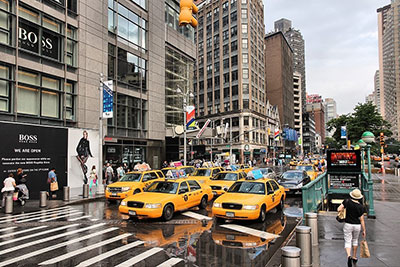Difference between Ride And Drive: Unraveling the Distinctions
The difference between ride and drive is that “ride” refers to being a passenger in a vehicle, while “drive” refers to operating or controlling the vehicle. When you ride in a vehicle, you are being transported by someone else who is driving.
On the other hand, when you drive, you have control over the vehicle’s movements and direction. This distinction is important in understanding the roles and responsibilities of individuals in a car or other transportation modes. Whether you’re sitting back and enjoying the ride or taking charge behind the wheel, understanding the difference between ride and drive helps clarify the dynamics of being a passenger or driver.

Credit: www.lma-consultinggroup.com
What Is A Ride?
A ride refers to an experience where passengers are transported from one place to another. It focuses on providing a pleasant and enjoyable journey for the passengers. The definition of a ride is centered around the passenger experience, ensuring their comfort and safety throughout the trip.
Examples of rides include thrilling theme park rides, exciting amusement park rides, and everyday public transportation. Rides are designed to cater to the needs and preferences of the passengers, offering them an efficient and convenient mode of transportation. Whether it’s the adrenaline rush of a roller coaster or the reliability of a bus ride, rides play a crucial role in our daily lives, making travel more convenient and enjoyable.
What Is A Drive?
A drive refers to the act of operating a vehicle, such as driving a car or riding a motorcycle. It involves controlling the vehicle and navigating through traffic. The definition of a drive encompasses the various methods of transportation, from driving a car to piloting an aircraft.
When someone is “on a drive,” they are actively engaged in driving or piloting a vehicle. The emphasis is on the physical act of operating the vehicle and being in control of its movements. Whether it’s maneuvering through city streets or flying through the sky, a drive is about being behind the wheel or the controls and taking charge of the transportation process.
Key Distinctions Between Rides And Drives
Passive participation in a drive allows the passenger to sit back and observe. In contrast, active participation is expected during a ride, where enjoyment is the main focus. The operator or ride designer has control over a ride, while a driver takes charge during a drive.
Rides are created for amusement, while drives are primarily for transportation and completing tasks. These key distinctions between rides and drives highlight the different roles of passengers. They can either passively enjoy the experience or actively engage in the journey.
So, whether you’re looking for entertainment or simply need to get from point A to point B, understanding the difference between rides and drives is crucial. Which one suits your purpose and intention?
Factors That Influence The Experience
Rides often provide exhilarating sensations with drops, twists, and turns that create thrilling experiences. On the other hand, drives offer the feeling of speed and freedom while cruising on the open road. Safety is an important consideration for both rides and drives.
Rides have safety measures in place to protect passengers during intense movements, while drives require adherence to traffic regulations and safe driving practices. Accessibility and availability differ between rides and drives. Rides may have restrictions based on height, age, or health conditions, whereas drives require a valid driver’s license and access to a vehicle.
Overall, the experience of a ride and a drive can vary significantly due to these factors, providing unique opportunities for excitement and enjoyment.
The Role Of Technology In Rides And Drives
Technology has revolutionized the way we experience rides and drives. Virtual reality technology allows us to immerse ourselves in thrilling and interactive experiences during rides. Animatronics and special effects further enhance the ride experience, making it more realistic and captivating.
In terms of driving, technology has brought about significant advancements as well. The rise of autonomous vehicles and self-driving cars is changing the way we navigate the roads. Moreover, advanced safety features like lane departure warnings and automatic braking systems have greatly improved driver safety.
These technological innovations not only make rides and drives more enjoyable but also prioritize safety and efficiency. With future advancements on the horizon, it is clear that technology will continue to play a primary role in shaping the future of transportation.
Frequently Asked Questions For Difference Between Ride And Drive
What Is The Difference Between Driving And Riding?
Driving is controlling a vehicle’s movements, while riding involves being a passenger and not being in control.
Is It Drive Or Ride With You?
You ride with us, not drive.
Do You Ride Or Drive A Horse?
You ride a horse, not drive it. Riding a horse involves sitting on its back and directing its movement.
Do You Say Drive Or Ride A Motorcycle?
You ride a motorcycle.
Conclusion
To summarize, it is clear that there are distinct differences between riding and driving. While both involve the act of being in a vehicle, riding focuses on being a passenger, enjoying the experience without direct control. On the other hand, driving emphasizes the responsibility of controlling the vehicle, requiring skills and knowledge.
Understanding these disparities is crucial for those who plan on making transportation choices or stepping into the driver’s seat. From the perspective of safety, comfort, and autonomy, the choice between riding and driving can greatly impact one’s travel experience. Whether it’s the convenience of a taxi ride or the freedom of steering your own car, each option has its own unique advantages and considerations.
Ultimately, it is essential to acknowledge these dissimilarities and choose the mode of transportation that aligns with personal preferences and circumstances.
